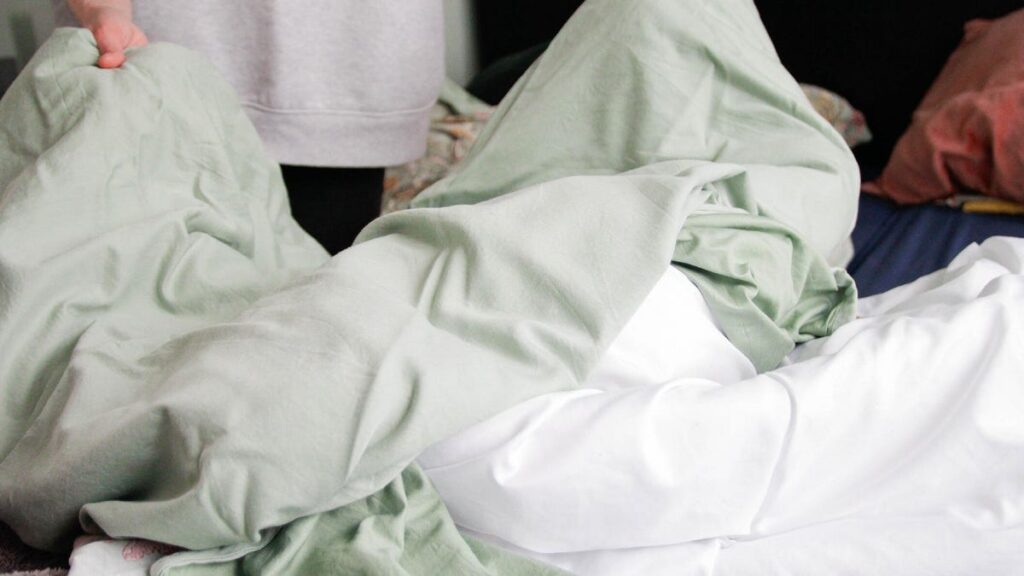Grounding sheets are piquing curiosity and reportedly helping people catch more Zzz, too. The claim is that grounding sheets that connect to an electrical outlet or directly to the ground outside connect the sleeper to the Earth’s electrical energy. The theory is that this connection can bring health improvements, such as better sleep, lower pain, reduced stress, improved healing and more.
The positive effects of grounding on inflammation, immune response, wound healing and disease prevention and treatment have been studied for years. Does this new earthing sheet TikTok trend have any merit?
What are grounding sheets?
Grounding sheets may be a TikTok trend, but the concept is not new. They are the latest in a line of conductive grounding systems, joining grounding socks, shoes, patches and rods. These conductive systems are created for people who can’t or choose not to be outdoors barefoot but still desire the benefits of grounding.
How do grounding sheets work?
The sheets look very similar to regular bed sheets, except they’re woven with a conductive material like carbon or silver and then connected to a power outlet or directly onto the ground outside.
When sleeping on earthing sheets, your body is said to reconnect with the Earth’s electrical energy by absorbing its negatively charged electrons. This helps balance out the positively charged electrons that build up in the human body, and this homeostasis is responsible for a variety of health benefits, according to proponents.
Popular grounding sheet brands
Lean on popular brands with a solid reputation and good reviews. Here are some popular brands:
The science behind grounding
Grounding, or earthing, is the concept that humans have gradually become disconnected from the Earth’s surface electrons and that reconnection with these electrons offers positive health results. Grounding occurs when you walk barefoot outside or connect to a conductive system (like grounding sheets) that serves the same purpose.
Research supports the grounding hypothesis that earthing is akin to other basic physiological needs like food, water, air and movement. Other studies on earthing mats (a close cousin of earthing sheets) reveal anxiety reduction and improved stress responses.
Potential health benefits of grounding sheets
The health benefits of using grounding sheets mirror the health benefits of using direct (barefoot-to-earth) grounding or other conductive systems. Benefits will also vary based on how much time you spend grounding daily.
Improved sleep quality
Cortisol is an important hormone produced by your body to regulate stress response, blood pressure, blood sugar, inflammation and sleep. Too much cortisol can degrade your ability to sleep and the quality of sleep you get.
Studies show that grounding while sleeping reduces cortisol levels, and the result is often better sleep.
Reduction in inflammation and pain
Grounding seems to have beneficial physiological changes. The electron transfers that occur during grounding are the basis for anti-inflammatory activity, according to a study on grounding’s impact on inflammation and inflammatory diseases. A similar study revealed that the occasional “recharging” with the Earth’s surface is optimally effective against chronic inflammation.
Stress reduction and relaxation
Although studies on grounding’s effect on stress are limited, some research has shown that grounding positively impacts stress and anxiety. One study using grounding mats (similar to grounding sheets) concluded that grounding sets “the biological clocks for the hormones that regulate stress responses.”
Enhanced mood and mental well-being
One study on grounding observed 40 adults who were either given a grounded pillow or a non-grounded pillow. Although the study agrees that more extensive studies should be conducted on the topic, the results were clear. Pleasant and positive moods were improved among those with the grounded pillow compared to those with the non-grounded pillow.
Improved chronic conditions
With all the other benefits grounding brings to the human body, you may be wondering if it can improve chronic illness. While experts agree grounding does not replace proper medical care, they also agree that grounding can counteract some chronic illness like auto-immune disorders, cancer, cardiovascular, diabetes, neurodegenerative and respiratory conditions.
Things to consider before using grounding sheets
Here are some risks to consider before you make your earthing bed tonight:
- Since grounding sheets require an electrical connection, be sure to check outlets with a grounding device before use to avoid electrical shock.
- If you have chronic conditions or take prescription medications, check with your medical doctor before you start grounding.
How to use grounding sheets
When you get your grounding sheets, the first thing to do is test the ground on your electrical outlet. Many grounding sheet sets come with a tester. If your outlet tests well, you’re ready to put the sheets on the bed like any other sheets. Run the cable somewhere safe where you or others won’t trip over it, then plug it in.
The idea is that with as much skin-to-sheet contact as possible, you’ll gain the most benefit from your ground sheets. If you want to wear pajamas, avoid synthetic materials that would impede the electrical connection.
Choosing the right grounding sheets
Since grounding sheets are part of a trend, beware of fake or subpar products that may be floating around the internet. Here are some tips for selecting the best grounding sheets for your needs:
- Watch out for non-conductive materials and unusually inexpensive price tags compared to competitors.
- If you value easy maintenance and machine washability, make sure the sheets you’re buying are machine washable.
- Make sure you order the proper size sheet for your bed. Grounding sheets should be the same size as any other sheet you’d use on your bed.
- Most grounding sheets are cotton, silk or polyester. Polyester is said to be superior for electrical resistance, but you should select the fabric you like sleeping on most.
- Look for low opposition electrical resistance, which indicates better grounding.
Read the full article here


